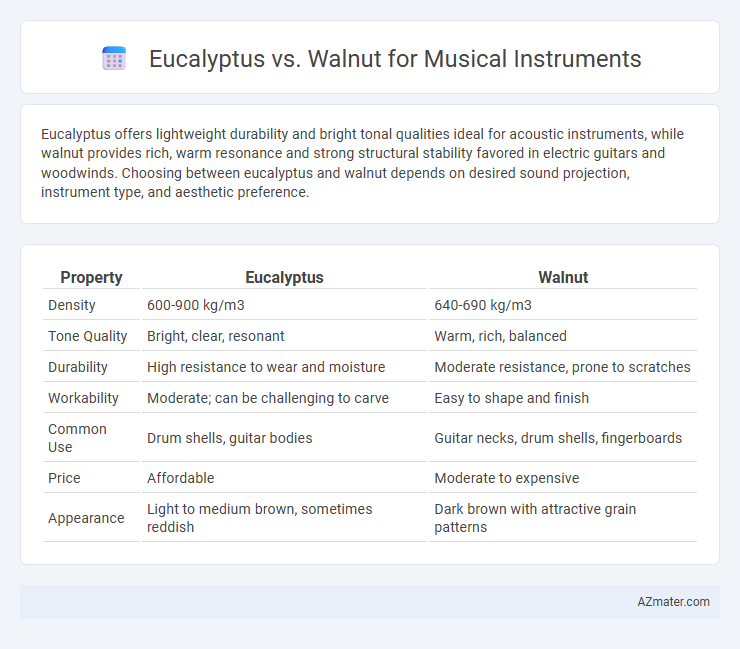Eucalyptus offers lightweight durability and bright tonal qualities ideal for acoustic instruments, while walnut provides rich, warm resonance and strong structural stability favored in electric guitars and woodwinds. Choosing between eucalyptus and walnut depends on desired sound projection, instrument type, and aesthetic preference.
Table of Comparison
| Property | Eucalyptus | Walnut |
|---|---|---|
| Density | 600-900 kg/m3 | 640-690 kg/m3 |
| Tone Quality | Bright, clear, resonant | Warm, rich, balanced |
| Durability | High resistance to wear and moisture | Moderate resistance, prone to scratches |
| Workability | Moderate; can be challenging to carve | Easy to shape and finish |
| Common Use | Drum shells, guitar bodies | Guitar necks, drum shells, fingerboards |
| Price | Affordable | Moderate to expensive |
| Appearance | Light to medium brown, sometimes reddish | Dark brown with attractive grain patterns |
Introduction to Eucalyptus and Walnut in Instrument Making
Eucalyptus and walnut are prized tonewoods in musical instrument making, valued for their distinct acoustic properties and aesthetic appeal. Eucalyptus offers a bright, clear sound with strong midrange frequencies, making it ideal for electric guitar bodies and drum shells due to its durability and resonance. Walnut provides a warm, balanced tone with excellent sustain and crisp attack, commonly used in acoustic guitar backs, sides, and violin backs to enhance tonal richness and visual elegance.
Wood Properties: Eucalyptus vs Walnut
Eucalyptus wood offers high density and hardness, providing excellent durability and resistance to wear, making it suitable for robust musical instruments with bright tonal qualities. Walnut wood features a fine, straight grain with moderate density, delivering warm, rich tones and good resonance ideal for guitars, violins, and other string instruments. The choice between eucalyptus and walnut depends on desired sound projection and aesthetic, with eucalyptus emphasizing strength and brightness while walnut prioritizes warmth and detailed tonal complexity.
Tonal Characteristics Comparison
Eucalyptus wood produces a bright, clear tone with pronounced midrange frequencies, making it ideal for instruments requiring sharp attack and excellent projection. Walnut offers a warmer, balanced sound with rich bass response and smooth treble, favored for its ability to blend clarity and warmth in acoustic and electric instruments. The tonal contrast between eucalyptus and walnut makes eucalyptus suited for sharp, articulate playing styles, while walnut excels in delivering a full-bodied, mellow sound.
Workability and Crafting Differences
Eucalyptus offers excellent workability for musical instruments due to its medium density and fine grain, allowing smooth carving and shaping with reduced tool wear. Walnut, denser and harder, requires sharper tools and more effort but provides superior durability and a rich tonal quality favored in guitars and violins. Differences in crafting highlight eucalyptus's ease for intricate details and walnut's strength for structural components, influencing choices based on instrument type and desired sound.
Durability and Longevity in Instruments
Eucalyptus wood offers exceptional durability due to its dense grain structure and natural resistance to moisture, making it a reliable choice for musical instrument bodies with long-lasting performance. Walnut, while slightly less dense, provides excellent structural integrity and ages gracefully, often enhancing tonal qualities over time without compromising strength. Both woods ensure longevity; however, Eucalyptus's superior hardness and stability under fluctuating humidity conditions give it an edge in maintaining instrument durability over decades.
Environmental Impact and Sustainability
Eucalyptus wood offers a faster growth cycle and is often harvested from sustainably managed plantations, making it a more renewable option for musical instruments compared to walnut, which grows slower and is frequently sourced from old-growth forests. The environmental impact of eucalyptus is lower due to its efficient carbon sequestration and regeneration rates, while walnut harvesting can contribute to deforestation and habitat loss if not responsibly managed. Choosing eucalyptus supports sustainability goals by reducing pressure on hardwood forests and promoting eco-friendly timber production in the musical instrument industry.
Cost and Availability in the Market
Eucalyptus offers a more cost-effective and widely available option for musical instruments compared to walnut, which is typically more expensive due to its slower growth and limited supply. Walnut's rich tonal qualities and aesthetic appeal drive higher demand, resulting in premium pricing and occasional scarcity in the market. Eucalyptus provides a sustainable alternative with consistent availability, making it ideal for budget-conscious musicians and manufacturers.
Popular Instruments Made from Eucalyptus
Eucalyptus wood, prized for its density and bright tonal qualities, is commonly used in making acoustic guitar backs, sides, and fingerboards, offering a clear, articulate sound preferred in folk and blues instruments. Popular instruments crafted from eucalyptus often feature enhanced sustain and resonance, making it a favorable choice for luthiers seeking durability and vibrant tone. While walnut is favored for its warm midrange and aesthetic appeal, eucalyptus stands out in instrument production for its strong projection and resistance to wear, especially in guitars and ukuleles.
Popular Instruments Made from Walnut
Walnut is renowned for its rich tonal qualities, making it a preferred choice for crafting guitars, ukuleles, and drums, where its warm sound and attractive grain enhance both acoustics and aesthetics. Eucalyptus, although used in some instruments, typically lacks the resonant depth and workability found in walnut, limiting its popularity in high-quality musical instrument production. The durability and balanced tonal response of walnut make it a dominant wood in luthier workshops, especially for electric guitar bodies and drum shells.
Choosing the Right Wood for Your Musical Instrument
Eucalyptus offers a bright, clear tonal quality with excellent sustain, making it ideal for acoustic guitars and percussion instruments, while walnut provides a warmer, richer sound favored in string instruments like violins and cellos. The density and grain structure of walnut contribute to its strong projection and durability, whereas eucalyptus is lighter and more resonant, impacting the instrument's overall weight and tonal response. Selecting the right wood depends on the desired sound profile and instrument type, with walnut preferred for deeper, mellow tones and eucalyptus chosen for crisp, articulate sound.

Infographic: Eucalyptus vs Walnut for Musical Instrument
 azmater.com
azmater.com